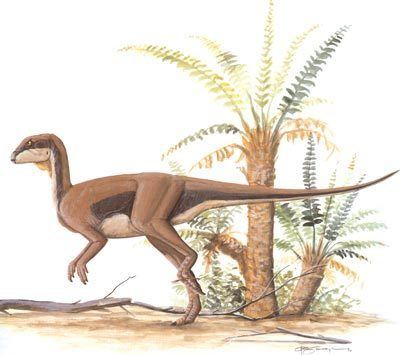Kingdom Animalia Clade Dinosauria Clade †Neornithischia Higher classification Hypsilophodont | Phylum Chordata Order †Ornithischia Scientific name Othnielia Rank Genus | |
 | ||
Similar Dinosaur, Dryosaurus, Othnielosaurus, Nanosaurus, Hypsilophodon | ||
Othnielia roar
Othnielia is a genus of ornithischian dinosaur, named after its original describer, Professor Othniel Charles Marsh, an American paleontologist of the 19th century. The taxon, Othnielia rex, was named by Peter Galton in 1977 from a species Marsh (1877) called Nanosaurus rex.
Contents

Description

Without the remains now included in Othnielosaurus, this animal is dubious, and can only be described in generalities based on similar animals. It was relatively small for a dinosaur, at around 1.5 to 2 metres (4.9 to 6.6 ft) long, and 10 kilograms (22 lb) in weight, and an agile bipedal herbivore with proportionally small arms and long legs. Animals of this genus were included in the novel Jurassic Park as "othys", tree-climbing small herbivores, although there is no evidence for this kind of behavior.
Discovery
Remains assigned to Othnielia have been found in Wyoming, Utah, and Colorado in rocks of the Late Jurassic age (Oxfordian-Tithonian) Morrison Formation, but with Galton's 2007 revision of Morrison ornithischians, the only definite remains are YPM 1925 (the holotype femur of "Nanosaurus" 'rex') and possibly some other associated postcranial bits. He considered the femur undiagnostic and thus Othnielia to be a dubious name, and removed two partial skeletons to the new genus Othnielosaurus. This scenario is reminiscent of the case in which complete remains originally placed in Lagosuchus were renamed Marasuchus.
Referred specimens
Only the original holotype of Othnielia and two partial skeletons were specifically dealt with in Galton's paper, leaving unsettled the assignment of several other specimens that have appeared in the literature. Included among these are a nearly complete specimen in the Aathal Dinosaur Museum nicknamed "Barbara", and a dentary (MWC 5822, again referred to O. rex). That Galton considered Othnielia a nomen dubium means that, according to him, these other specimens could not be referred to it.
DMNH 21716
Kathleen Brill and Kenneth Carpenter reported a baby ornithopod, possibly Othnielia rex from the Morrison Formation at Garden Park, Colorado in 2001. The specimen is catalogued as DMNH 21716. Evidence that DMNH 21716 was not fully grown include its small size, unfused neural arches, and the ends of its long bones are "spongy and incompletely formed." If the specimen is truly O. rex, it is about one third the size of a known adult specimen. However, the chronological age of the specimen could not be estimated because Othnielia eggs and hatchlings were unknown.
Ecology
Othnielia lived in Western America around 150 million years ago. The habitat was probably forest and open woodland. Other dinosaurs in the area included Sauropods (Brachiosaurus, Apatosaurus, Diplodocus and Camarasaurus), theropods (Allosaurus, Ceratosaurus and Ornitholestes), Stegosaurus and ornithopods (Camptosaurus and Dryosaurus).
